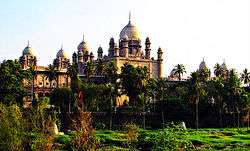List of High Courts of India
| This article is part of a series on |
| Judiciary of India |
|---|
 |
| Law of India |
|
Civil courts
|
|
Criminal courts
|
|
Executive Court
|
|
Legal profession
|
|
Legal education |
There are 24 High Courts at the state and union territory level of India which, together with the Supreme Court of India at the national level, comprise the country's judicial system. Each High Court has jurisdiction over a state, a union territory or a group of states and union territories. Below the High Courts is a hierarchy of subordinate courts such as the civil courts, family courts, criminal courts and various other district courts. High Courts are instituted as constitutional courts under Part VI, Chapter V, Article 214 of the Indian Constitution.[1]
The High Courts are the principal civil courts of original jurisdiction in each state and union territory. However, a High Court exercises its original civil and criminal jurisdiction only if the subordinate courts are not authorized by law to try such matters for lack of pecuniary, territorial jurisdiction. High courts may also enjoy original jurisdiction in certain matters if so designated specifically in a state or federal law.
However, the work of most High Courts primarily consists of appeals from lower courts and writ petitions in terms of Article 226 of the constitution. Writ jurisdiction is also original jurisdiction of High Court. The precise territorial jurisdiction of each High Court varies. The appeal order is the following: tehsil-kotwali-criminal/civil courts - district - high court - supreme court.
Each state is divided into judicial districts presided over by a District and Sessions Judge. He is known as a District Judge when he presides over a civil case, and a Sessions Judge when he presides over a criminal case. He is the highest judicial authority below a High Court judge. Below him, there are courts of civil jurisdiction, known by different names in different states. Under Article 141 of the Constitution, all courts in India (which includes High Courts) are bound by the judgments and orders of the Supreme Court of India by precedence.
Judges in a High Court are appointed by the President of India in consultation with the Chief Justice of India and the governor of the state. High Courts are headed by a Chief Justice. The Chief Justices are ranked fourteenth (in their state) and seventeenth (outside their state) in the Indian order of precedence. The number of judges in a court is decided by dividing the average institution of main cases during the last five years by the national average, or the average rate of disposal of main cases per judge per year in that High Court, whichever is higher.
The Calcutta High Court is the oldest High Court in the country, established on 2 July 1862. High Courts that handle a large number of cases of a particular region have permanent benches established there. Benches are also present in states which come under the jurisdiction of a court outside its territorial limits. Smaller states with few cases may have circuit benches established. Circuit benches (known as circuit courts in some parts of the world) are temporary courts which hold proceedings for a few selected months in a year. Thus cases built up during this interim period are judged when the circuit court is in session. According to a study conducted by Bengaluru-based NGO Daksh on 21 high courts in collaboration with Ministry of Law and Justice (India) in March 2016, it was found that average pendency of a case in High courts in India is 3 years.[2]
A systematic implementation of E-courts In India is the way to speed up the judicial process, reduce if not eliminate the ills of the judicial system - corruption, inefficiency and bias.
High Courts
The Chennai High Court in Chennai, Mumbai High Court in Mumbai, Kolkata High Court in Kolkata and Allahabad High Court in Allahabad are the oldest four High Courts in India.
The following are the 24 High Courts of India sorted by name, year established, Act by which it was established, jurisdiction, headquarters, benches, the maximum number of judges sanctioned and the presiding Chief Justice of the High Court.
High Courts by States/Union Territories
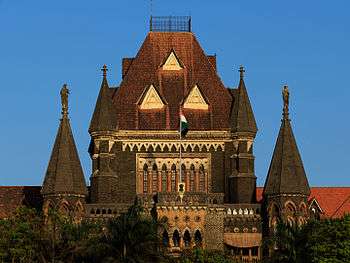
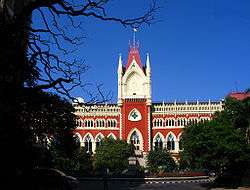
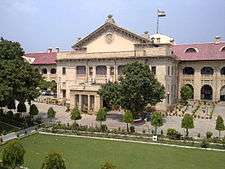
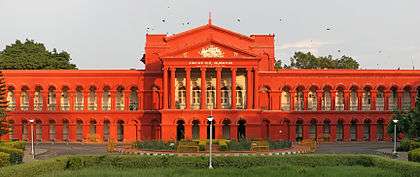

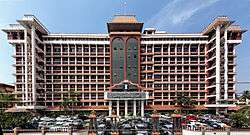
Courts under High Court
- District Courts of India
- District Munsiff Court
- Courts of Judicial Magistrate of First Class
- Courts of Judicial Magistrate of Second Class
- E-courts In India
See also
Notes and Citations
- ↑ "Indian Courts". Archived from the original on 21 Jul 2011. Retrieved 21 September 2012.
- ↑ "HCs taking 3 years on average to decide cases: Study".
- ↑ Originally established at Agra, it shifted to Allahabad in 1875.
- ↑ Originally known as Madras High Court, it was renamed as Chennai High Court in 2016.
- ↑ Lahore High Court was established at Lahore on 21 March 1919 and had jurisdiction over undivided Punjab and Delhi. On 11 August 1947 a separate Punjab High Court was created with its seat at Simla under the Indian Independence Act, 1947, which had jurisdiction over Punjab, Delhi and present Himachal Pradesh and Haryana. In 1966 after the reorganisation of the State of Punjab, the High Court was designated as the Punjab and Haryana High Court at Chandigarh. The Delhi High Court was established on 31 October 1966 with its seat at Simla which was later shifted to New Delhi in 1971 after the Himachal Pradesh was granted the statehood with its own High Court at Simla.
- ↑ Originally known as the High Court of Assam and Nagaland, it was renamed as Gauhati High Court in 1971.
- ↑ Originally known as Andhra Pradesh High Court, it was renamed High Court of Judicature at Hyderabad in 2014.
- ↑ "THE HON'BLE THE ACTING CHIEF JUSTICE RAMESH RANGANATHAN". hc.tap.nic.in. Retrieved 2016-09-14.
- ↑ "Justice Ranganathan is new acting Chief Justice of Hyerabad High Court - Times of India". Retrieved 2016-09-14.
- ↑ Srinagar is the summer capital; Jammu is the winter capital.
- ↑ Originally known as Mysore High Court, it was renamed as Karnataka High Court in 1974.
- ↑ The High Court of Travancore-Cochin was inaugurated at Cochin on 7 July 1949. The state of Kerala was formed by the States Reorganisation Act, 1956. That Act abolished the Travancore-Cochin High Court and created the Kerala High Court. The Act also extended the jurisdiction of the Kerala High Court to Lakshadweep.
- ↑ Originally known as Calcutta High Court, it was renamed as Kolkata High Court in 2016.
- ↑ Under the Government of India Act, 1935, a High Court was established at Nagpur for the Central Provinces by Letters Patent dated 2 January 1936. After the reorganization of states, this High Court was moved to Jabalpur in 1956.
- ↑ Originally known as Bombay High Court, it was renamed as Mumbai High Court in 2016.
- ↑ Originally known as Orissa High Court, it was renamed as Odisha High Court in 2011.
- ↑ Originally known as Punjab High Court, it was renamed as Punjab and Haryana High Court in 1966.
- ↑ Originally known as Uttaranchal High Court, it was renamed as Uttarakhand High Court in 2007.
References
- "Jurisdiction and Seats of Indian High Courts". Eastern Book Company. Retrieved 2 September 2005.
- "Judge strength in High Courts increased". Press Information Bureau–Govt. of India. Retrieved 2 September 2005.
- "Judiciary". Supreme Court of India. Retrieved 2 September 2005.
- "Constitution of India". Wikisource. Retrieved 31 December 2005.
- "Madras High Court". Hcmadras.tn.nic.in. Retrieved 24 December 2015.
- "Soon, High Courts in 3 northeastern States". Retrieved 11 May 2012.
- "New chief justice of Delhi high court to assume charge on Wednesday". Retrieved 6 November 2012.
External links
![]() Media related to High Courts in India at Wikimedia Commons
Media related to High Courts in India at Wikimedia Commons
